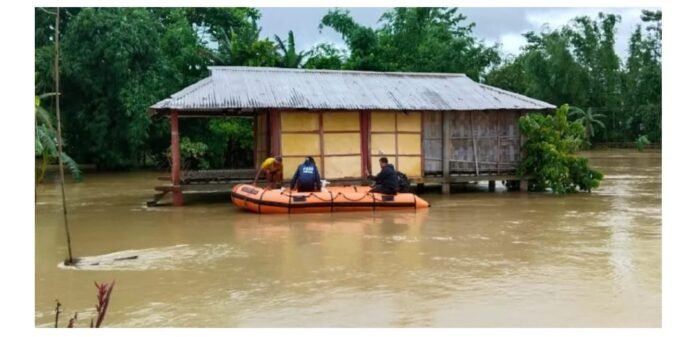Introduction:
The flood situation in Dhemaji district, Assam, has reached alarming levels, causing significant distress among the local population. With no signs of immediate respite, the district continues to battle the devastating impact of incessant rainfall and swelling rivers. The torrential downpours have led to widespread inundation, displacing thousands of residents and severely affecting their lives. As the district grapples with the repercussions of this natural calamity, urgent measures are required to alleviate the suffering and ensure the well-being of the affected individuals.
Flooded Landscapes and Human Impact: Dhemaji district, located in the northeastern state of Assam, has been struggling to cope with the grim flood situation. Heavy rains have resulted in the swelling of major rivers like the Brahmaputra and its tributaries, submerging vast stretches of land. The floods have disrupted essential services, damaged infrastructure, and left the lives of approximately 18,000 people in disarray. Many homes, farmlands, and livestock have been engulfed by the relentless waters, exacerbating the hardships faced by the affected communities.
Displacement and Evacuation Efforts:
As the floodwaters continue to rise, a large number of families have been forced to abandon their homes in search of safer ground. District authorities, in collaboration with disaster response teams, have been working tirelessly to carry out rescue operations and provide relief to the affected individuals. Temporary shelters and relief camps have been set up to accommodate those displaced by the floods, offering them basic amenities and essential supplies.
Health and Sanitation Challenges:
In addition to the immediate impact on shelter and livelihoods, the floodwaters pose serious health and sanitation challenges. Stagnant water serves as a breeding ground for waterborne diseases and increases the risk of infections. Access to clean drinking water, sanitation facilities, and healthcare services becomes limited during such crises, further endangering the well-being of the affected population. Efforts are being made to address these concerns by ensuring the provision of clean water, hygiene kits, and medical aid.
Call for Support and Assistance:
The situation in Dhemaji district demands immediate attention and support from various stakeholders. The government, non-governmental organizations, and civil society must collaborate to provide timely relief and rehabilitation to the affected communities. Financial aid, relief materials, and resources are crucial to meet the pressing needs of the flood-affected population. Furthermore, long-term measures, such as the construction of embankments and improved drainage systems, need to be implemented to mitigate the impact of future floods.
Conclusion:
As the flood situation in Dhemaji district, Assam, remains grim, the resilience and strength of the affected communities are being tested. It is imperative for both the government and the citizens to work hand in hand to overcome the challenges posed by this natural disaster. By extending support, resources, and empathy, it is possible to alleviate the suffering of those affected and facilitate the process of recovery and rebuilding. With concerted efforts, Dhemaji district can rebuild itself, stronger and more resilient than before, in the face of such adversity.




